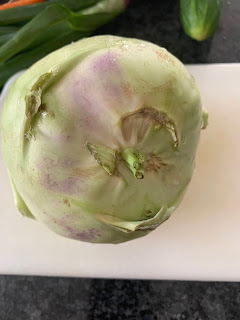If you grew up in Wisconsin, you probably grew up eating raw kohlrabi. In my home, we had kohlrabi slices next to our sandwiches instead of potato chips (and as kids, we were not too happy about that).
Yet, if you grew up with this vegetable and you have not had it for a while, you might find a taste of it will bring back fond memories. It does make a great snack, and the new juicier, tender varieties taste better than you will remember.
Kohlrabi (pronounce it like coal-robby) is in the family of vegetables that includes turnips, rutabaga, Brussels sprouts, cabbage, kale, broccoli and cauliflower. These vegetables mostly were grown in Europe and then later brought to the Americas. Kohlrabi is popular in the US with families of German heritage. Even the name is German: Khol for cabbage and Rabi for turnip.
Wisconsin's cooler climate is very similar to the climate in Germany, and kohlrabi grows really well here. The plant looks pretty weird as it grows. The leaves are light green, and are good to cook and eat just like you would cook collard greens or kale. The bulb part grows above the soil, and is actually part of the stem. It can be white-ish, light green and even purple. No matter the color of the stems or the bulb on the outside, the inside of the kohlrabi bulb is bright white.
 |
| Small kohlrabi bulb growing in the All Peoples Darius Simmons Community Garden |
If you are growing kohlrabi, don't let it get too big! Most varieties of kohrabi get tough or "woody" (hard to chew, like if you were trying to chew wood) if the bulb gets too big. When the bulb is about the size of a baseball, it is just right for picking. A softball size kohlrabi will be too big and tough to eat.
When it is ready, you can harvest the kohlrabi by picking the plant right up out of the soil. Cut off the leaves and wash them. Cut them up and prepare them just like you would any kind of green.
 |
| The top of the kohlrabi bulb |
 |
| The bottom or root side of the kohlrabi bulb |
The bulb is prepared by peeling it. Like rutabaga, kohlrabi has a waxy outside skin and an inner tough skin. You need peel off the skin in order to eat kohlrabi raw or to cook it.
Raw kohlrabi is good to eat in slices, chopped or shredded on salads. It is also a good vegetable to serve with dip or hummus.
 |
| Cut a thin slice to cut the top off |
 |
| The root side can be tough, find the place where it is tender and cut it off |
 |
| Inside, the flesh is white and juicy |
 |
| Use a sharp knife to carefully peel away the waxy outer and green inner skin. |
 |
| Once the kohlrabi is peeled, you can cut it up however you like. |
Raw kohlrabi is good to eat in slices, chopped or shredded on salads. It is also a good vegetable to serve with dip or hummus.
Thin slices or strips of kohlrabi are very good as a substitute for bamboo shoots in Chinese dishes or as a nice crunchy addition to any stir fry.
So if you come on over to the All Peoples garden and you see these weird green or purple balls with leaves growing out of them, you have found the kohlrabi. They do look a little bit like garden aliens. Usually kohlrabi are ready to harvest in early to mid-July. Maybe you will get lucky and can find some freshly harvested kohlrabi on the garden stand so you can take it home and try it.


No comments:
Post a Comment